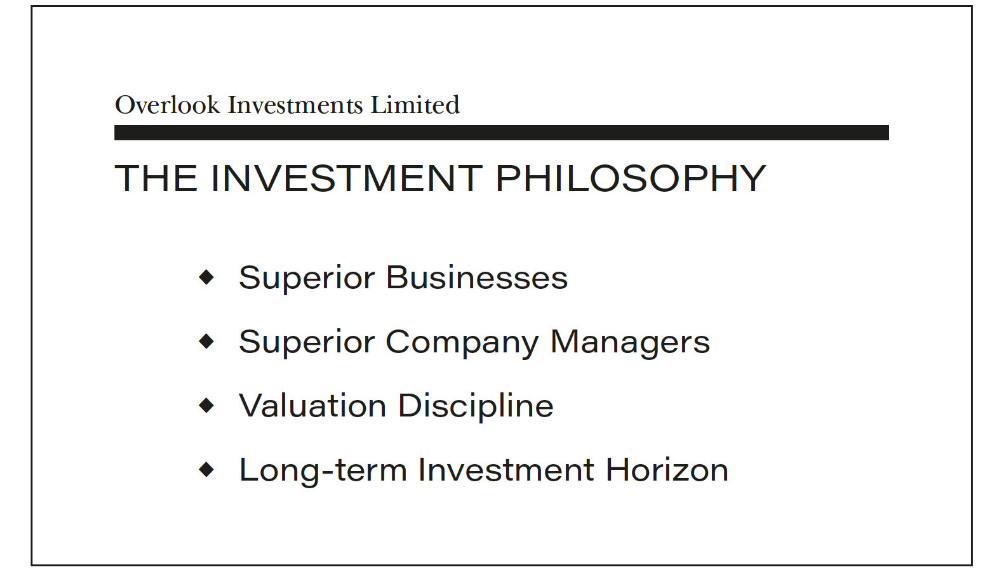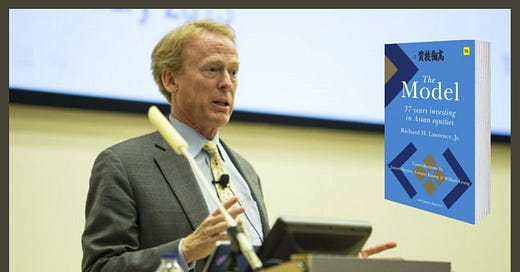Learning from Richard Lawrence of Overlook - 14.3% CAGR for 30 years
Fund cap on subscriptions and capital-weighted returns (CWR)
From a question to a book recommendation
A few months back, I was deciding on the structure and terms of my investment fund, Vision Capital Fund. I wanted to learn more about instituting a fund cap to limit investor inflows and moderate the pace at which the fund will grow. I wanted the fund cap to increase our runway for producing long-term outstanding investment returns for decades and to smooth any potential future investor inflows/outflows through market cycles.
To an active investment manager, size is the enemy of returns. It is often what drives long-term underperformance. The larger a fund's starting size, i.e., assets under management (AUM), and the faster it grows by gathering more capital over time, the shorter the runway and the lower the future investment outperformance.
"If I was running $1 million today, or $10 million for that matter, I'd be fully invested. Anyone who says that size does not hurt investment performance is selling. The highest rates of return I've ever achieved were in the 1950s. I killed the Dow. You ought to see the numbers. But I was investing peanuts then. It's a huge structural advantage not to have a lot of money. I think I could make you 50% a year on $1 million. No, I know I could. I guarantee that." - Warren Buffett
My dear friend Chong Ser Jing, who runs The Compounder Fund, recommended Richard H. Lawrence Jr.'s book The Model: 37 Years Investing in Asian Equities.
Richard Lawrence is one of the top stalwarts of the Asian investment scene. He founded Overlook Investments Group in Hong Kong in 1991, focusing on investing in public equity markets throughout Asia, excluding Japan.
As of 2022, Overlook managed over US$6bn of AUM and achieved a 14.3% p.a compounded return for 30 years, outperforming the universe by 6.5%.
That said, Overlook did, too, have its fair share of difficulties. Given its focus on Asia, it was significantly negatively impacted during the 1997-1998 Asian Financial Crisis, and it managed to secure an additional US$30 million investment from the Yale Investment Office from David Swensen in the summer of 1998 to tide it through.
Understanding Overlook’s Investment Approach
Overlook’s successful 30-year history is based on the consistent execution of The Overlook Model (“Model”).

Richard Lawrence states that Overlook’s investment philosophy has four key pillars. These pillars are used to assess each new investment idea:
Superior business: High profit margins, predictable Earnings Per Share (EPS) growth, rational capital allocation, and strong pricing power.
A management team with integrity: Management’s track record in terms of 1) capital allocation, 2) operational excellence, 3) leadership/strategy, and 4) alignment of interests.
A bargain valuation: New ideas are compared to their peers, apple to apples. Valuation needs to be low in absolute terms.
Long-term investment horizon: Overlook prefers to invest in businesses with long-term track records, preferably a decade or longer.

Below are the characteristics that Overlook believes are typically associated with superior companies:
High Profitability: Superior businesses possess high profitability in virtually every case. In addition to being the hallmark of successful business performance, high profitability leads to the generation of free cash flow that makes dividends and equitable corporate governance easy for executives to deliver to shareholders.
Predictable EPS Growth: EPS growth is a critical driver for success. Few things more negatively impact performance than an unexpected decline in earnings, so they must find high-quality companies that deliver predictable EPS growth. Overlook’s experience has shown that the following attributes are commonly found in companies that are able to maintain steady growth: low cyclicality of business; steady demand for its products or services; ability to increase market share; and a track record of consistent earnings over a long period of time.
Successful Allocation of Free Cash Flow: One critical determinant of future performance is a corporation’s allocation of free cash flow between reinvestment for future growth and the return of capital to shareholders via dividends or share buybacks. Effective reinvestment into future growth can be a complicated challenge for management. To be justified, reinvestment must clearly enhance a company’s future business.
Dominant Pricing Power: Pricing power is the most valuable corporate asset. It is valuable during recessions and equally valuable during growth, deflation, and inflation. The more pricing power a company has, the better.
The approach is then summarised through “The Overlook Pyramid”, with just a few stocks at the top exhibiting high return on equity, low debt levels and other markers of superior businesses. Lawrence now tells his team to concentrate on the stocks at the top of the pyramid, ensuring that by doing so, “you will outperform the benchmark”.

Investors who can manage to push their portfolio toward the top of the Pyramid and keep it there for at least five years are likely positioned to generate outperformance over the universe.
There are two caveats. First, investors cannot badly overpay for these great companies. Even modest overpayment detracts from outperformance. Foolish overpayment eliminates all the hard work undertaken to identify superior businesses run by great executives.
Second, as the fund grows in size, a higher proportion of holdings will overlap with the universe, threatening the fund’s ability to generate non-correlated gains.
Richard believes that outperformance can and should be achieved methodically, consistently, and reliably over extended periods of time, and I wholeheartedly agree.
Richard Lawrence’s book provided more detailed examples of Overlook’s investment approach, which I will not share further. Instead, I highly recommend that you read it.
Now, let us seek to understand Overlook’s cap on subscriptions.
How the Legal Cap on Subscriptions can smoothen fund inflow volatilty and make a fund antifragile
The birth of Overlook’s Cap on Subscriptions originated when Richard Lawrence had lunch in 1992 in New York with Crosby Smith, a representative of the Dillon Family. Richard was asked why he would not just raise capital to generate fees like other investment managers. Crosby proposed that if Richard limited initial subscriptions into the fund at $30 million, the Dillon Family would invest $1 million. They shook hands, and Overlook had its first investor.
The Overlook Cap on Subscriptions was born in that spontaneous moment for Overlook. Richard Lawrence thought that the Cap on Subscriptions has proven to be the single most significant business decision in their 30-year history. In the early 1990s, Overlook decided to cap new subscriptions at 8-9% growth per year. This policy enabled the company to grow its AUM steadily.
A certain percentage of investors will always get caught in a liquidity squeeze, or panic at the unfolding of a bear market, and redeem. It is unavoidable even how hard we do our best to ensure the appropriateness and suitability of our investors. This may not be our fault, but it is something we have to deal with as fund managers. We need replace the redeeming capital with new investors so that the fund is not forced to sell the crown jewels / its holdings.
The unintended effect of the subscription cap (and when the fund does well), is that there is a waiting list for new investments, and when managed properly can provide a backlog of investors interested to invest, when others run for cover.
Effectively, the Cap on Subscriptions can smooth fund inflows, effectively lowering the cyclical volatility of AUM. One can then limit inflows of funds at the top of the market, have a ready queue of investors waiting to jump in during market declines, effectively making an investment fund more anti-fragile especially during market selloffs.
In addition, the Cap incentivizes investors to make a long-term commitment, which is aligned with a long-term investment horizon. Investors usually have to wait 6–12 months to gain access, so there are no short-term gains for investors trying to time the markets. The Cap effectively self-selects patient long-term investors.
What is the downside of having such a Cap? As you can imagine, such a Cap on Subscriptions is not for AUM/asset gatherers. The fund size grows much slower and takes longer to scale, and investment managers collect much lower fees.
Cap on Subscriptions improving Investor’s returns
Before we proceed, we need to understand the difference between TWR and CWR / MWR and what matters to the investor.
Time-weighted return (TWR): The TWR calculates the compound growth of a portfolio's Net Asset Value on a per-share basis over a specified period of time. Fund managers most often disclose this number.
Capital-weighted return (CWR): CWR calculates the Internal Rate of Return (IRR) for an individual investor’s return and the return collectively earned by all investors in the fund. The CWR accounts for all cash flows into and out of the investor’s specific account and the fund since inception. Most fund managers do not report CWR, and CWRs typically underperform TWRs for most funds.
The Discount (the “Discount”) and the Premium: The discount is the difference between the TWR and the CWR for a specific fund. Discounts occur when CWRs are lower than and underperform TWRs. Peter Lynch was producing world-leading returns when he ran Magellan (high TWR), but the underlying investors performed far worse (low CWR).
Discounts typically happen for two reasons:
First, a fund manager can generate exceptional results as measured by TWRs at the fund's inception when assets under management (AUM) are small. Then, the manager gets “discovered” and/or “promoted,” and an explosion of money enters the fund, to the great delight of the fund manager. However, with the larger asset base, the now-famous fund manager performs poorly, dragging down his TWR while crushing his CWR.
Second, CWRs are hurt when investments are poorly timed. Investors chase funds promoting hot themes, then bail out when markets turn down. This behavior inevitably decreases their CWRs. But even buying smartly and selling poorly, or buying poorly and selling smartly, can result in a Discount.
On average, the Discount increases when some of the following conditions prevail:
Funds experience fast growth of AUM: the Discount tends to increase as the absolute value of a fund increases.
Funds are invested in trendy asset classes.
Funds are exposed to excessive valuation risk.
Funds have excessive exposure to fund-of-funds’ investors.
Funds are operated in higher volatility sectors.
Richard Lawrence strongly believes that fund managers should “own” their CWRs and disclose them. Below is Overlook’s CWR vs. TWR, and it is about the same, which is really impressive.

PS: On a side note, prior to this, I was unaware of and had never calculated my CWR for Vision Capital. At that time (4 Jun 2024), over the last 7+ years, my CWR was 16.3% p.a. and 19.0% p.a. TWR (calculated using Portseido), which, thankfully, the discount was not horrendously significant. Phew!
Richard realized that the elimination of Overlook’s Discount is overwhelmingly due to their legal Cap on Subscriptions. At first, he thought it was due to the success of their Investment Philosophy or the luck of their investors in timing their investments.
Overlook’s Investment Philosophy has helped them achieve outperformance of our TWR vs. the benchmark, but it did not impact CWR. The investors' luck is not a factor either, as their investors have added funds consistently over time.
Instead, the answer lies exclusively in the legal Cap on Subscriptions because the Cap has allowed a limited amount of funds to enter Overlook steadily over the past 30 years. Control over the growth of AUM is the key to eliminating the Discount. The legal Cap on Subscriptions is the hero of Overlook’s story.
Why don’t fund managers seek to eliminate the discount?
Suppose the Cap allowed Overlook to eliminate the Discount. Could all fund managers eliminate their own Discounts if they adopted a legal cap on subscriptions to limit the growth of subscriptions consistently to approximately 8–9% per year? Richard Lawrence’s answer is a resounding “Yes.”
If managers could deliver between 400-900bps per year of additional performance for their investors by embracing the Cap, why wouldn’t they? Their clients would be loyal, and their business would have an excellent long-term outlook.
As we all probably know, Wall Street and the fund management industry are incentivized around the accumulation of AUM and accumulation of their own wealth, not their clients’ wealth or the generation of CWRs.
What makes Richard really mad is that it is very probable that some portion of the largest (read: greedy) hedge fund managers have large Discounts despite positive TWRs.
Deeply inspired by Overlook and Richard Lawrence
At Overlook, they seek to deliver superior investment returns by putting the interests of our investors above all else.
Overlook is in this business for one purpose: to deliver results to their investors in terms of capital-weighted returns over time for each investor and the Overlook Community of investors. That is their measure of success.
They control AUM with the legal Cap on Subscriptions and by returning capital to Overlook investors when deemed necessary.
Learning from the grand master himself
The next day, after I finished reading the book and gathering my thoughts, I cold-emailed Richard Lawrence, wanting to learn more in-depth details of the fund cap and implement it for Vision Capital Fund.
To my surprise, Richard quickly responded two hours later, and we had a 30-minute call the very same day before his flight the next day. He was extremely kind and gracious to have done so and to share his learnings with me.
I learned so much more in greater detail and had better context. Overlook’s fund cap started from 8-9%, lowering gradually to mid-single digit percentages over time. It then changed to a hard absolute cap as the fund grew larger over time. Now, it has a no net new capital hard cap, which means any new capital is a replacement of capital that is leaving.
Applying to Vision Capital Fund
At Vision Capital Fund, we are deeply inspired and resonate very well with Richard Lawrence and Overlook’s investment philosophy and framework. We too never wanted to be an AUM gatherer, which also explains why our management fees too scale lower as AUM grows.
We know if we can generate long-term excellent returns for our investors, the inflows from existing and new investors will come, and the fund will grow in size over time. Our preference is that we prefer the majority of the growth of fund AUM comes from the returns we generate for our investors, rather than inflows. We don’t need to be the largest, but we want to be exceptional, to be one of the best after a long time.
All I wanted for Vision Capital Fund was for us to be able to keep investing well for long periods of time, and to keep doing this without size impeding our returns, for as long as we can, for the next 20-40+ years.
I decided that we would employ a similar fund cap on subscriptions for our investors too at Vision Capital Fund. Once the fund AUM exceeds USD 25 million, the 10% fund cap of 10% will kick in, limiting annual net fund inflows to 10% of AUM.
We will seek to report our CWR in addition to the standard TWR, and we are working with our fund administrator and broker on this. It will not be easy, but we will seek to report them the moment we reasonably can.
I know it will be slower for us to grow, but it will be above sufficient operating scale where significant fund operating leverage kicks in, but we will have a longer runway to grow, without size being the enemy of returns.
We are not in a hurry to maximise our growth in any given year, but are focused on optimizing our growth for the long-term.
We rather be a slow growing tree with deep roots, and a strong solid foundation, that can stand up to harsh environments of cold temperatures and high winds, than to be a fast-growing tree, with shallow roots, that is uprooted and collapses at the first sight of trouble (which is inevitable).
I hope more investment managers will join us in this call to arms, adopt their own version of the subscription cap, and report their capital-weighted returns (CWR) as well. Together, over time, we can become a mighty, growing force of good.
15 September 2024 | Eugene Ng | Vision Capital Fund | eugene.ng@visioncapitalfund.co
Find out more about Vision Capital Fund.
You can read my prior Annual Letters for Vision Capital here. If you like to learn more about my new journey with Vision Capital Fund, please reach out.
Follow me on Twitter/X @EugeneNg_VCap
Check out our book on Investing, “Vision Investing: How We Beat Wall Street & You Can, Too”. We truly believe the individual investor can beat the market over the long run. The book chronicles our entire investment approach. It explains why we invest the way we do, how we invest, what we look out for in the companies, where we find them, and when we invest in them. It is available for purchase via Amazon, currently available in two formats: Paperback and eBook.
Join my email list for more investing insights. Note that it tends to be ad hoc and infrequent, as we aim to write timeless, not timely, content.






